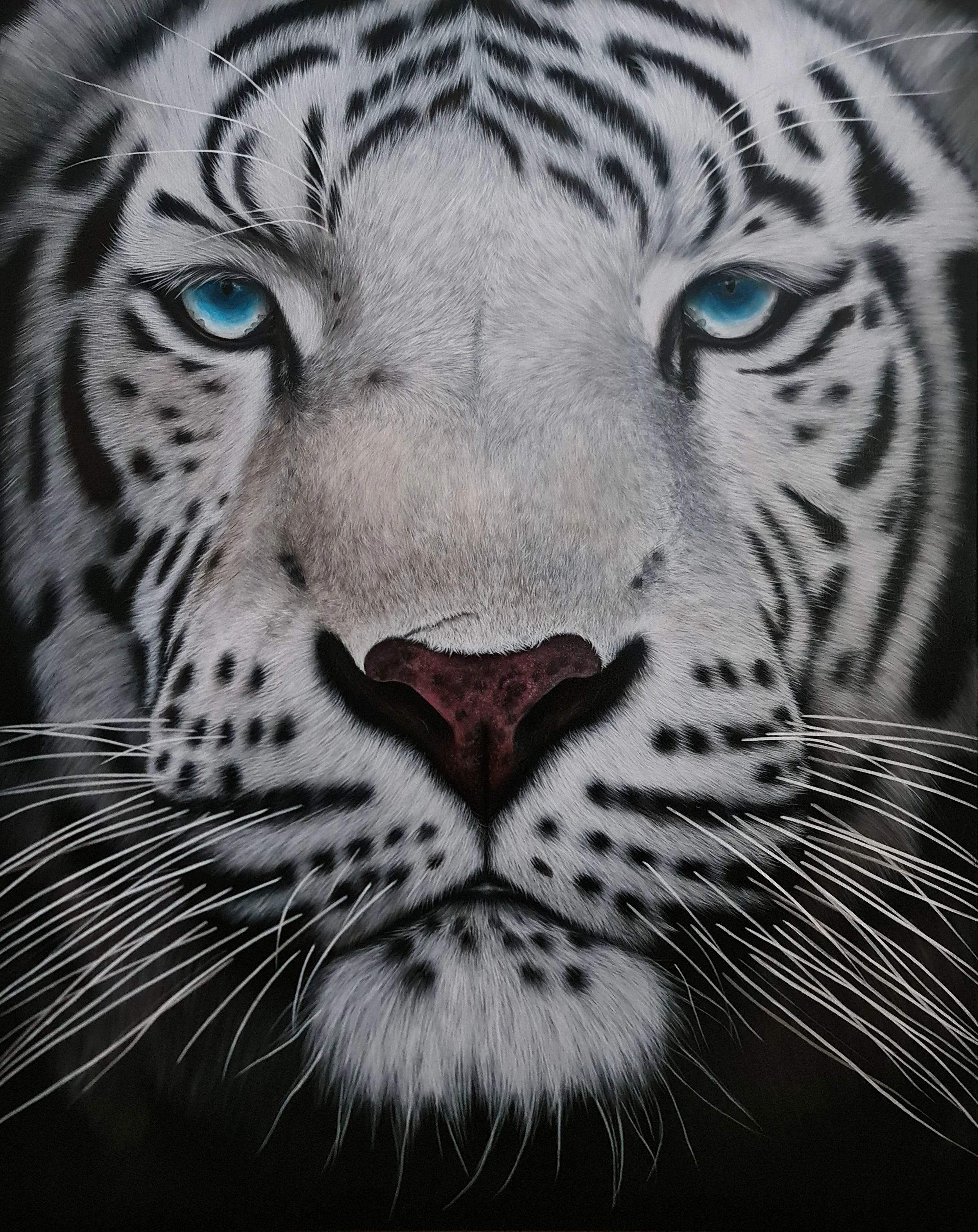10 Questions with Paulina Wróblewska
Paulina Wróblewska is a self-taught Polish artist specialising in large-scale, hyperrealistic acrylic paintings. Her work focuses on animals, often portrayed in striking, emotionally resonant compositions that blend photographic precision with a strong painterly presence. Based in Poznań, Poland, she has quickly gained recognition for her technical skill and unique visual language.
Her paintings have been featured in art auctions, including Desa Unicum and Art in House, where they consistently attract collectors.
Paulina Wróblewska - Portrait
ARTIST STATEMENT
“My goal as an artist is simple yet powerful: I want the viewer to stop – even just for a moment – and truly look. To look into the eyes of the subject. To feel something.
I paint animals with a deep emotional intensity because I believe their presence, expression, and gaze can speak to something very human in us. There is a silent language in their eyes – strength, fear, dignity, curiosity – and I aim to translate that onto canvas in a way that resonates beyond the surface.
Working in acrylic on large-scale canvases allows me to focus on detail and expression. I want my paintings to confront the viewer – not aggressively, but quietly and directly – inviting them into a private, intimate exchange. It's not about decoration or aesthetic beauty alone; it's about emotion, connection, and the feeling that the subject is watching us back.
Through each piece, I try to create more than an image. I try to create a presence – something that lives, breathes, and waits to be seen.”
— Paulina Wróblewska
Aira, 2025 © Paulina Wróblewska
INTERVIEW
Let's start from the basics. You're a self-taught artist. How did your journey into painting begin, and what led you to focus on animals?
Yes, I started with traditional drawing and digital drawing. I created realistic portraits on a graphic tablet, that's where I learned how to really see: to analyse light, shape, and proportion. I never had any formal art education. Everything I know today came from trial and mistakes and daily, persistent work. Painting with traditional media came unexpectedly, one day I just bought a canvas and acrylics to try it out, and… I was hooked. I haven't stopped since. As for animals, they've always been close to me. Their gazes, their postures, they speak volumes without words. When I paint them, I feel like I'm touching something real. I'm especially drawn to big cats, their strength, calm, and wildness at the same time. They have a kind of presence that I want to preserve on canvas.
What drew you to hyperrealism, and how did you develop your technique with acrylics on such a large scale?
Hyperrealism allows me to capture emotion in the smallest gestures, in the gaze, the tension of a muscle, the glint in an eye. The more realistic something is, the more it feels alive. I developed my technique through repetition. No one taught me, I just painted every day. I learned by analysing my mistakes. I work in layers, starting with light and form, gradually building up detail. Acrylic lets me return to the same areas again and again to refine them. Large-scale formats give me space, both physically and symbolically, to go deeper, to create presence that works from afar and up close.
Svar, 2025 © Paulina Wróblewska
Your paintings often feel deeply emotional. What role does emotion play in your creative process?
Emotion is everything. I don't paint to make something "pretty." I want the painting to look back at the viewer, to feel like a presence in the room. Sometimes I begin a painting just because one gaze moved me deeply. Before I even touch the canvas, I spend a long time analysing reference photos, looking for that one detail that carries an emotion, something that speaks without words. That silent message is the most important part. If a painting doesn't breathe, I don't finish it.
How do you choose the animals you paint, and what do you look for in their expression or gaze?
It's a purely intuitive process. Sometimes one photo, one moment, one gaze, stops me in my tracks. I don't look for anatomical perfection. I look for the truth. A gaze that holds you. Tension in the body. Something unposed and honest. I want to paint someone, not something.
Can you walk us through your typical process, from the idea to the finished canvas?
It starts with a feeling, something that strikes me emotionally. Then I search for reference images and analyse them deeply. I often combine several photos, adjust the composition, and the light, all digitally, on my tablet. Only when the painting is fully formed in my head and on the screen do I move to the canvas. I sketch directly on the canvas and paint in layers, starting with overall light and form, then building detail. I return to certain areas many times. I spend the most time on the eyes, they need to feel alive and create a connection.
Ziya, 2025 © Paulina Wróblewska
Asur, 2025 © Paulina Wróblewska
ChybaTy, 2025 © Paulina Wróblewska
Gio, 2024 © Paulina Wróblewska
You've said you want your paintings to feel like a presence. How do you create that sense of intimacy and connection?
It's all in the gaze. The eyes create the relationship between the painting and the viewer. I want the painting not just to be looked at, but to look back. I want the viewer to feel that someone is really there. That silent connection, it's everything. I also create it through simplicity. I avoid distractions. The background is often neutral, so it doesn't interfere with that moment of encounter.
What challenges do you face when trying to balance photographic realism with a strong painterly touch?
The biggest challenge is not to overdo it. It's easy to get lost in perfection, and when that happens, the emotion gets lost too. I always try to find balance. I want the painting to be precise, but still alive. I intentionally leave the texture visible; sometimes, I blur or simplify certain areas. The most powerful moments happen in between, between realism and painterly presence.
Your work has appeared in auctions and gained interest from collectors. How has this shaped your artistic direction, if at all?
It gave me courage. At first, I painted without knowing if it even made sense, I wasn't sure anyone would connect with it. When my works started to appear at auctions and collectors responded, I felt that it was worth continuing. That people see and feel something in them. It hasn't changed my core intention, but it gave me a push to go deeper, to be braver and more honest.
Wild Eyes, 2025 © Paulina Wróblewska
What do you hope viewers take away after spending time with one of your pieces?
I hope they pause. That they feel the gaze, that, even for a moment, it feels like a real encounter, not just with the painting, but with something inside themselves. If the painting lingers with someone, if they fall silent after looking at it, then it worked.
Are there any upcoming projects, subjects, or themes you're excited to explore in your future work?
Definitely, I'm currently working on three parallel series. "Wild Cats" are large-format portraits of wild cats that embody presence and strength. I want the viewer to feel like they're face to face with the animal. "Wild Eyes" are close-up studies of wild animal eyes. These are more intimate, focusing solely on the gaze. I want them to act like emotional mirrors: quiet, but deep. "Między" (which means in between) is a new body of work exploring transitional states: between strength and fragility, between visibility and disappearance, between control and surrender. These are quiet, tense, emotionally raw paintings, very personal to me. They speak about presence, but also about absence.
Artist’s Talk
Al-Tiba9 Interviews is a promotional platform for artists to articulate their vision and engage them with our diverse readership through a published art dialogue. The artists are interviewed by Mohamed Benhadj, the founder & curator of Al-Tiba9, to highlight their artistic careers and introduce them to the international contemporary art scene across our vast network of museums, galleries, art professionals, art dealers, collectors, and art lovers across the globe.






















